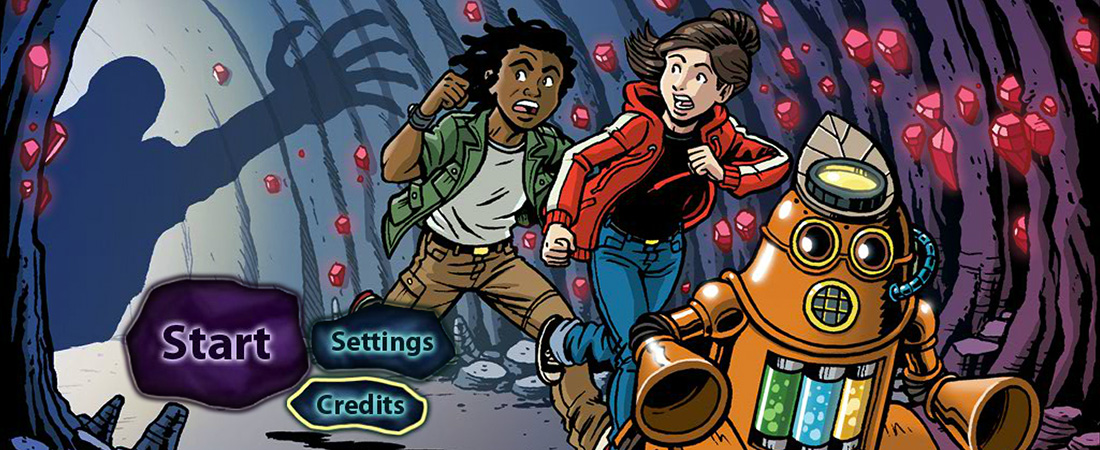Science at Play

Biobot Bob helps students playing The Ruby Realm learn about science.
A self-described videogame fanatic, Lucas Fox is bullish about the role that video games can play in the classroom.
“When a kid sits down to game, he is sitting down to solve complex problems that he is interested in,” says the seventh-grade teacher from Kingston, New York. “We need to use games in education.”
Fox recently put his theory to the test. As part of his instruction during a unit on photosynthesis, he asked students to play The Ruby Realm, a video game created by EDC and game design company 1st Playable Productions.
In the game, students direct a glucose-powered robot named “Biobot Bob” around a vast, perilous cave in search of missing friends. Bob moves and defends himself by using a molecule replicator to break apart carbon dioxide and water molecules into glucose and tear gas. The challenge? Students have to find hidden shafts of light to jumpstart this process—and then they have to build the molecules that Bob needs.
All the fun is meant to engage students in concepts critical to understanding photosynthesis: new substances can be created through chemical change.
As Fox had predicted, the game was a hit.
“The game presented an encompassing and engrossing idea,” he says. “It was different and unique.”
The Ruby Realm is one of four digital games developed as part of EDC’s Possible Worlds project, a five-year research and development center funded by the U.S. Department of Education’s Institute of Education Sciences. The project examined whether digital games could help teachers resolve student’s common, difficult-to-dislodge misconceptions about various scientific phenomena.
Now, all four games—which cover photosynthesis, heredity, electricity, and heat transfer—and their accompanying classroom materials are available for free on the Possible Worlds website.
Making learning fun for everyone
EDC’s Katie Culp led the Possible Worlds research team. A game enthusiast herself, she says that she was interested in the role that video games could play within the delicate ecosystem of teachers, learners, and science curricula. However, students were not her only audience.
“We wanted to carve out a space that connected academic research, commercial game development, and teachers in a new way,” she says. “Many educational games have shown themselves to be good at generating student assessment data, but there is very little conversation about how educational games connect with what teachers need to do with kids or how to help teachers teach.”
The Possible Worlds team knew that if the gameplay felt like drudgery, students would not want to spend any time in the elaborate digital world they were creating. So developing games that maintained student interest was a key goal.
“We wanted kids to recognize these as commercial games,” says EDC’s John Parris, who managed the design and production team. He credits co-principal investigator Cornelia Brunner, formerly with EDC, with much of the vision behind the games.
“Cornelia strove to develop something fun for students that teachers could also mine for productive discussion about difficult science concepts,” says Parris. “She saw that digital games were that unique place where students would tolerate frustration and persist in the face of failure. Those are the very habits we want to encourage in school more broadly. So the key was developing games which were authentic and allowed this type of engagement to occur.”
Parris also sees the Possible Worlds’ teacher-led strategy as different from other commercially driven educational games.
“Game designers often think about students as their target audience, and they try to build something that is going to change the way kids think just by playing the game” he says. “But we took another approach, which was to create truly playful experiences that required teachers to complete the connections to science content.”
Progressive learning experience
Culp stresses that the Possible Worlds games are meant to offer a framework for students and teachers to talk about scientific phenomena.
“There’s a lot of interest right now in using games in instruction to let kids have individualized learning experiences,” says Culp. “But I go back to a progressive idea of learning, where learning requires multiple experiences with a topic over time and in the context of genuine social interaction. So I think games can be great at the beginning of the process, but it’s really about creating an instructional arc that supports kids repeatedly bumping up against concepts.”
Culp’s team creates such an instructional arc by pairing interesting video games with classroom activities that support the key scientific lessons being taught. One such activity is called No Way!, and it requires students to work in teams to examine the scientific validity of unbelievable-but-possibly-true stories. In one No Way! story, students discuss whether a single tomato plant could produce 32,000 tomatoes.
Erin Nelson, who also teaches middle school science in Kingston, New York, says that the No Way! activities prompted something she seldom saw in her classroom—scientific disagreement.
“It’s sometimes difficult to get middle schoolers to express their true feelings on a matter if they feel like they are the minority,” she explains. “But with No Way!, there were kids who would raise their hands and say, ‘No, I don’t think that’s true.’ My students got really into it.”
